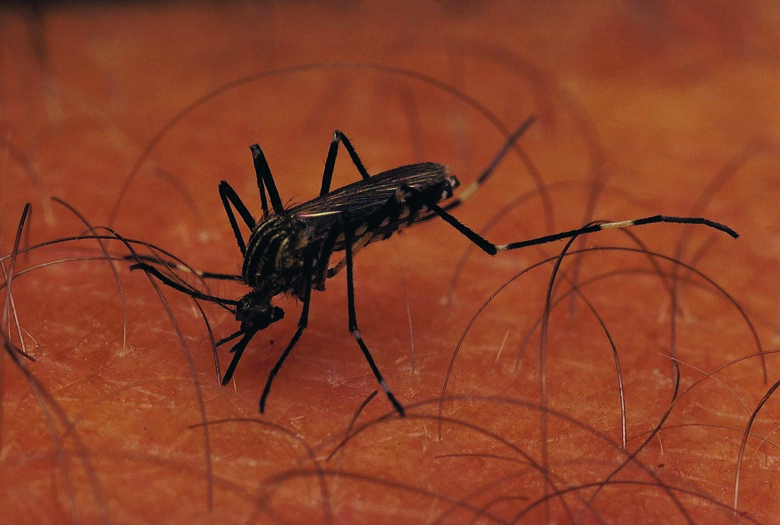What Percent Of DEET Is Effective?
If DEET is so effective a mosquito repellant, why wouldn't you want to apply 100 percent DEET? Because it is likely to be more expensive, and depending upon how long you need protection, 4 percent DEET may be all you need. Research has shown that a higher concentration of DEET does not improve its repellent properties, but does provide longer-lasting protection. A concentration of 20 percent provides almost four hours of protection.
DEET Facts
DEET Facts
DEET is N,N-diethyl-meta-toluamide, which repels mosquitoes and ticks including the ticks that cause Lyme disease. It was developed by the U.S. Army in 1946 before being released for public use in 1957. Currently, DEET is available in concentrations between 4 percet and 100 percent, in more than 140 products in lotion, spray, liquid and impregnated forms (like wristbands).
On the downside, users complain that DEET in higher concentrations is known to be greasy, smell bad and corrode synthetic fabrics.
Research on DEET Concentrations
Research on DEET Concentrations
Researchers in 2002 undertook an experiment comparing the effectiveness of several commercially available insect repellents against mosquito bites. M.S. Fradin and J.F. Day tested the repellents on 15 volunteers who placed their arms into a test cage containing 10 young female mosquitoes. The researchers recorded the time before the first mosquito bite.
They concluded that "DEET-based products provided complete protection for the longest duration. Higher concentrations of DEET provided longer-lasting protection. A formulation containing 23.8 percent DEET had a mean complete-protection time of 301.5 minutes.
The New England Journal of Medicine published the article "Comparative Efficacy of Insect Repellents against Mosquito Bites" in its July 4, 2002 edition.
Complete Protection Time Increases with Concentration
Complete Protection Time Increases with Concentration
The researchers tested 16 products in total, six of which contained DEET. The concentrations and mean duration of protection are as follows:
23.8 percent: 301.5 minutes (just over five hours) 20 percent: 234.4 minutes (just under four hours) 6.65 percent: 112.4 minutes (almost two hours) 4.75 percent: 88.4 minutes (just under an hour and a half)
As the researchers observed, "The alcohol-based product containing 23.8 percent DEET protected significantly longer than the controlled-release formulation containing 20 percent DEET." Two wristbands impregnated with a concentration of 9.5 percent DEET provided effectively no protection.
Criticisms
Criticisms
One physician complained in a letter to the NEJM that "Drs. Fradin and Day failed to include in their study a repellent with a DEET concentration greater than 23.8 percent." This particular writer was a resident of "bush" Alaska who swore by 95 percent concentrations of DEET.
The researchers answered that most DEET products (at the time) contained 40 percent DEET or less, though a few were available at 95 percent. They claimed that "DEET's duration of action tends to plateau at concentrations higher than 50 percent, so relatively little additional benefit is afforded by 95 percent DEET." That 50 percent plateau is widely reported, though the source of that information is uncertain.
Information, Misinformation and Anecdotal Evidence
Information, Misinformation and Anecdotal Evidence
Every source seems to tell a different story about DEET's effectiveness. The Travel Medicine Alliance, an Australian alliance of medical doctors, advises that while the duration of protection is related to the concentration of DEET, "At a concentration of 50 percent, this effect plateaus. 30 percent DEET is the lowest effective dose." So they agree with Fradin and Day about the plateau, but seem off the mark about the lowest effective dose.
The South Carolina Department of Health and Environmental Control claims that "The efficacy of DEET plateaus at a concentration of 30 percent, the maximum concentration currently recommended for infants older than 2 months, children and adults." (See Reference 5.) This contradicts EPA recommendations which are that DEET is approved for use on children with no age restriction, and that there is no restriction on the percentage of DEET for use on children.
Anecdotally, Program Coordinator Andrew Yasso of the American Alpine Institute (an organization of mountain climbers) observed that "Most companies say 100 percent DEET will last around 10 hours, and I think that's about right, but it doesn't matter because you will know when its effectiveness stops (it's rather dramatic)."
References
- US Environmental Protection Agency: The Insect Repellent DEET
- New England Journal of Medicine; Comparative Efficacy of Insect Repellents against Mosquito Bites
- New England Journal of Medicine: Letters
- Travel Medicine Alliance: Safety of DEET
- South Carolina Department of Health and Environmental Control: Mosquitoes
- American Alpine Institute – Climbing Blog: Insect Repellent
Cite This Article
MLA
Antony, Dan. "What Percent Of DEET Is Effective?" sciencing.com, https://www.sciencing.com/what-percent-of-deet-is-effective-12759120/. 15 December 2013.
APA
Antony, Dan. (2013, December 15). What Percent Of DEET Is Effective?. sciencing.com. Retrieved from https://www.sciencing.com/what-percent-of-deet-is-effective-12759120/
Chicago
Antony, Dan. What Percent Of DEET Is Effective? last modified March 24, 2022. https://www.sciencing.com/what-percent-of-deet-is-effective-12759120/
